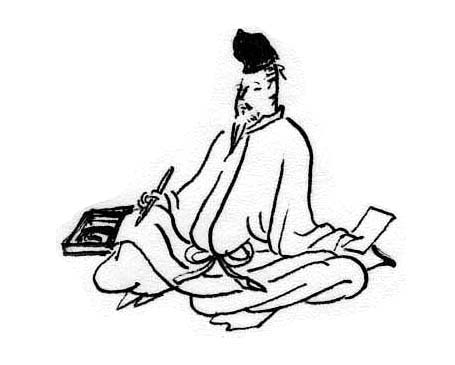|
||
 |
||

(C)2001 Japanese Architecture and Art Net Users System. No reproduction or republication without written permission.
掲載のテキスト・写真・イラストなど、全てのコンテンツの無断複製・転載を禁じます。
|
||||||
| Hitomarozou 人麿像 | ||||||
| KEY WORD : art history / paintings | ||||||
| Also
Hitomaruzou 人丸像. An imaginary portrait of the Nara period poet Kakinomoto
no Hitomaro 柿本人麿, who is considered the greatest poet of the MAN'YOUSHUU 万葉集, the first major anthology of Japanese verse (last dated poem 759). A low-ranking
member of the courts of Empress Jitou 持統 (r. 690-97) and Emperor Monmu 文武 (r.
697-707), by the mid-11c he came to be regarded as the patron saint of poets,
uta no hijiri 歌聖. By this time, however, most readers could no longer decipher
the archaic writing system of the MAN'YOUSHUU. Many of the favorite Hitomaro
poems were later found to be spurious attributions. In 1118 Fujiwara no Akisue
藤原顕季 (1055-1123) instituted a ceremony of homage to Hitomaro, Hitomaro eigu
人麿影供, modelled after similar ceremonies in honor of Confucius and his disciples
sekiten 釈奠 held at the Imperial academy daigakuryou 大学寮. The focal
point of the ceremony was a portrait painting based on one commissioned by Fujiwara
no Kanefusa 藤原兼房 (1003-69) to specifications he received in a vision of the poet
during a dream. In terms of iconography, however, Kanefusa's image seems based
on earlier Chinese paintings of the famous Tang poet Bai Juyi (Jp: Haku Kyoi
白居易, 772-846; also known as *Haku Rakuten 白楽天). A depiction of
a Chinese gentleman or poet in this tradition is preserved in The Landscape
Screen Senzui byoubu 山水屏風 (late 12c; formerly in Touji 東寺, now in Kyoto
National Museum). Although there are many images of Hitomarozou --- some
depicting him leaning on an armrest kyousoku 脇息, or those in the rocky
grotto style iwayaryuu 岩屋流, or in Tang period costume --- the oldest tradition
has an aged Hitomaro with a long dignified beard, dressed in a soft, unstarched
outer robe noushi 直衣 with wide trousers gathered at the ankles sashinuki
指貫. This Heian period costume is given an air of antiquity by a floppy cap eboshi
烏帽子. In his left hand the poet holds some paper, in his right a brush, apparently
in the midst of composing a poem. The earliest extant example of the orthodox
image is contained in the Satake 佐竹 version of The Thirty-six Immortal Poets
Handscroll Sanjuurokkasen emaki 三十六歌仙絵巻 (second quarter of the 13c), now
divided up and dispersed; a portion showing Hitomarozou can be found in
Idemitsu 出光 Museum of Art. |
||||||
 |
||||||
| REFERENCES: | ||||||
| EXTERNAL LINKS: | ||||||
| NOTES: | ||||||
(C)2001 Japanese Architecture and Art Net Users System. No reproduction or republication without written permission. 掲載のテキスト・写真・イラストなど、全てのコンテンツの無断複製・転載を禁じます。 |
||||||